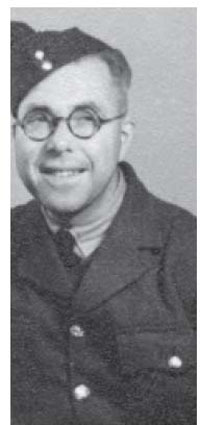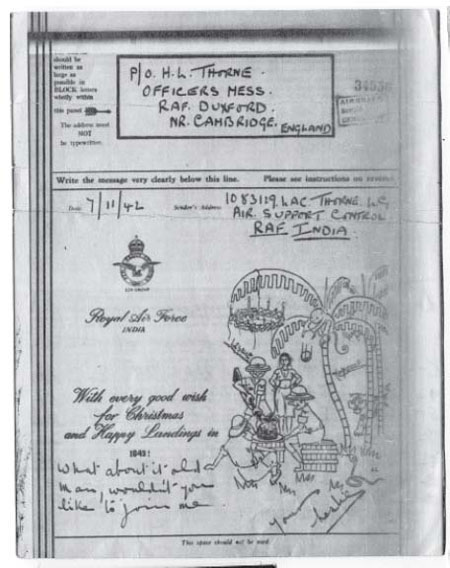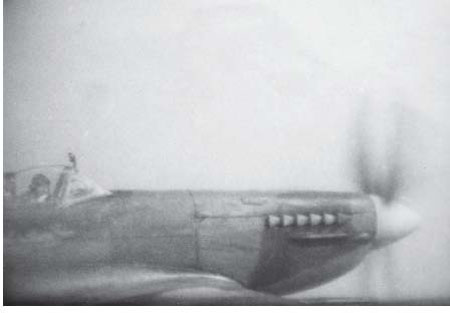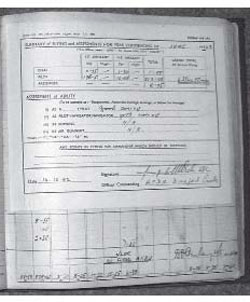A Very Unusual Air War (25 page)
Read A Very Unusual Air War Online
Authors: Gill Griffin

8 November
: When carrying out fighter affiliation at distant airfields we became temporary members of the Officers’ Mess, in this case Dishforth in North Yorkshire, a pre-war permanent station. Financially this was good for us, as when on temporary detachment we paid no mess bills other than for drinks.
9 November
: Catterick was still the home base of 41 Squadron so this would have been a quick visit to see old friends.
The Halifax was the third of the new breed of four-engined bombers, similar to the Lancaster in appearance, apart from the square tails and Bristol radial engines. It never quite reached the achievements of the Lancaster in bomb-carrying capacity and performance, although some Halifax crews would disagree. Losses in action were also heavier than those of the Lanc. Nevertheless, the Halifax made a useful contribution to the bombing campaign. Later in the war they were used as glider tugs.
10 November
: The final flight was aborted after we set out for Dishforth. As we flew farther north, the weather conditions worsened and we were forced back to base. As the bad weather persisted, fighter affiliation exercises were discontinued, apart from one sortie against some Stirlings.
16 November
: I have no recollections of this crash; it must have been a very minor one as I continued flying as usual. I also note that BG549 was flying again ten days later, on November 26th. After a pilot was proficient on a type he was always credited with pilot time even if he was not actually flying the aircraft. It is more than possible that in this instance P/O Walker was the pilot.
26 November
: Squadron Leader Swales (always known as Blondie) courted and married one of the Duxford WAAF officers. Blondie remained at AFDU for some months after taking over from Jock Murray. I never knew either of those officers by their actual Christian names, always Jock or Blondie. After the war Blondie flew helicopters as a civilian and was kidnapped by members of the IRA and forced, at knife point, to land in the courtyard of the Maze Prison in Ireland. Three of the prisoners boarded the helicopter and made a successful escape but were later recaptured.
28 November
: The Spitfire Mk 1X went into service in the late summer of 1942 in the HF (high flying) version. This type’s 2-speed, 2-stage, supercharger was set to give best performance at heights up to 40,000 feet. The LF (low flying) version followed to give its best performance at 18 and 25,000 feet. These two types covered the performance with speeds superior to the Focke Wulf FW 190 at almost every altitude.
30 November
: The Germans had started to use ME 109s and FW 190s for hit and run bombing raids, initially on towns in the coastal areas. These came to be known as the Baedeker raids. This was the first trial of the Spit for use as a fighter-bomber.
| Summary for:- November 1942 | 1 Spitfire | 17–55 |
| Unit:- AFDU Duxford | 2 Stinson | 5–10 |
| Date:- 1/12/42 | 3 Oxford | −55 |
| Signature:- H.L. Thorne | | |
E. Smith
Sqdn Ldr
O/C Flying AFDU Duxford
| YEAR | 1942 | AIRCRAFT | Pilot or 1st Pilot | 2nd Pilot, Pupil or Pass. | DUTY (Including Results and Remarks) | Flying Time | Passenger | ||
| MONTH | DATE | Type | No. | Dual | Solo | ||||
| December | 1st | Spitfire | S | Self | | Delivery to Cranfield | | −15 | |
| | | Oxford | BG549 | F/Lt Sewell | Self | To Hucknall | | −45 | |
| | | Oxford | BG549 | F/Lt Sewell | Self | To base | | −45 | |
| | 4th | Spitfire | K | Self | | Air test and dog fight | | −40 | |
| | | Spitfire | P | Self | | Home guard beat up | | −45 | |
| | | Spitfire | K | Self | | Air test with modified ailerons | | −50 | |
| | | Stinson | ? | Self | 3 passengers | To Foulsham | | −35 | |
| | 7th | Stinson | ? | Self | 2 passengers | To Martlesham Heath | | −35 | |
| | | Stinson | ? | Self | 2 passengers | To base | | −40 | |
| | 8th | Spitfire | P | Self | | Circuit and landing | | −15 | |
| | | Mustang | 618 | Self | | Sliding hood test | | | |
| 9th | Spitfire | BS543 | Self | | Speed trials | | −45 | | |
| | | Spitfire | P | Self | | Camera gun trials, air to ground | | −45 | |
| | 11th | Spitfire | P | Self | | Air test | | −25 | |
| | 12th | Spitfire | P | Self | | Camera air to air | | −40 | |
| | | Spitfire | P | Self | | Camera and gun fire into the sea | | −45 | |
| | 16th | Spitfire | L | Self | | Aileron air test | | −20 | |
| | 28th | Spitfire | A | Self | | Aileron air test to 30,000ft | | 1–00 | |
| | | Spitfire | P | Self | | Aileron air test to 30,000ft | | −55 | |
| | 30th | Spitfire XII | EN223 | Self | | Air test climbs to 10,000ft | | −35 | |
| | 31st | Stinson | ? | Self | | To Snailwell | | −2- | |
| | | Stinson | ? | Self | | To base | | −2- | |
| | | | | | | GRAND TOTAL TO DATE 629 hours 50 minute s | 3–30 | 8–25 | |
| | | | | | | | 60–00 | 557–55 | 8–50 |
1 December
: Hucknall was the Rolls-Royce engine production factory and development department with an airfield nearby. Following the trials in June of the P51 Mustang Mk 1 and its unfavourable reception due to poor performance at altitude, Mr. Ronnie Harker, the Rolls-Royce chief test pilot, was invited to Duxford to add his opinion to that of AFDU. The story we believed at that time was that Wing Commander Campbell-Orde had said, ‘Take the Mustang back to Hucknall and fit a Merlin 60 series engine similar to that installed in the Mk1X Spitfire.’ Whoever had the idea, it was tried out, the Mustang was transformed and the war-winning fighter aircraft was born. The Americans graciously accepted the change and agreed to fit future Mustangs with the Merlin power plant. As Rolls-Royce could not meet the additional demands for Merlins, two American companies were licensed to produce Merlins, not only for the Mustang but also for one version of the Spitfire, the Mk XV1, which also had US .5mm. machine guns.
4 December
: The Foulsham trip was probably air experience for members of Cambridge Home Guard following the ‘beat up’ the previous day. I wonder whether one of them fell out, as there were only two of them on the next flight!


Christmas card received by Len Thorne from his elder brother, Leslie, serving in India.

8 December
: The original Mustang had an ‘up and over’ canopy (like the ME 109); it had to be closed for take-off and could not be opened in flight. Its framing also interfered with visibility. Mustang 618 was probably a Mk111 powered by a Merlin 61 and was intended for service with both the RAF and the USAAF. To improve all-round visibility an experimental Spitfire (and Hurricane) type sliding hood was fitted. The new type of canopy was an immediate success and proved to
be very popular with the pilots. In the next two years there were several variations to the shape of the canopy, mainly the teardrop and the bubble.

Summary of flying and assessment, June–December 1942.
11 December
: Every RAF aircraft had to be given a daily inspection (DI0) and the results recorded on Form 700. The various members of the Ground Fitter E (engines) and Fitter A (airframes, electrician, instruments and armaments) signed their appropriate section, countersigned by the NCO in charge and finally by the pilot before flight. Any work between flights, such as repair, correction or maintenance was always the subject of an air test.
